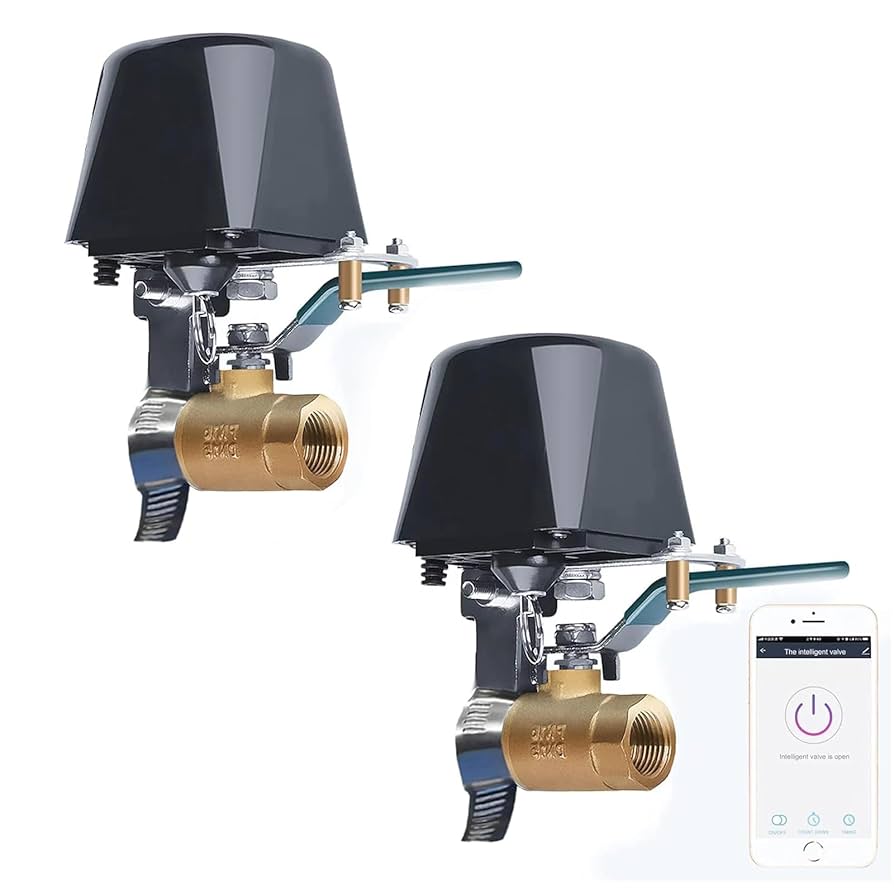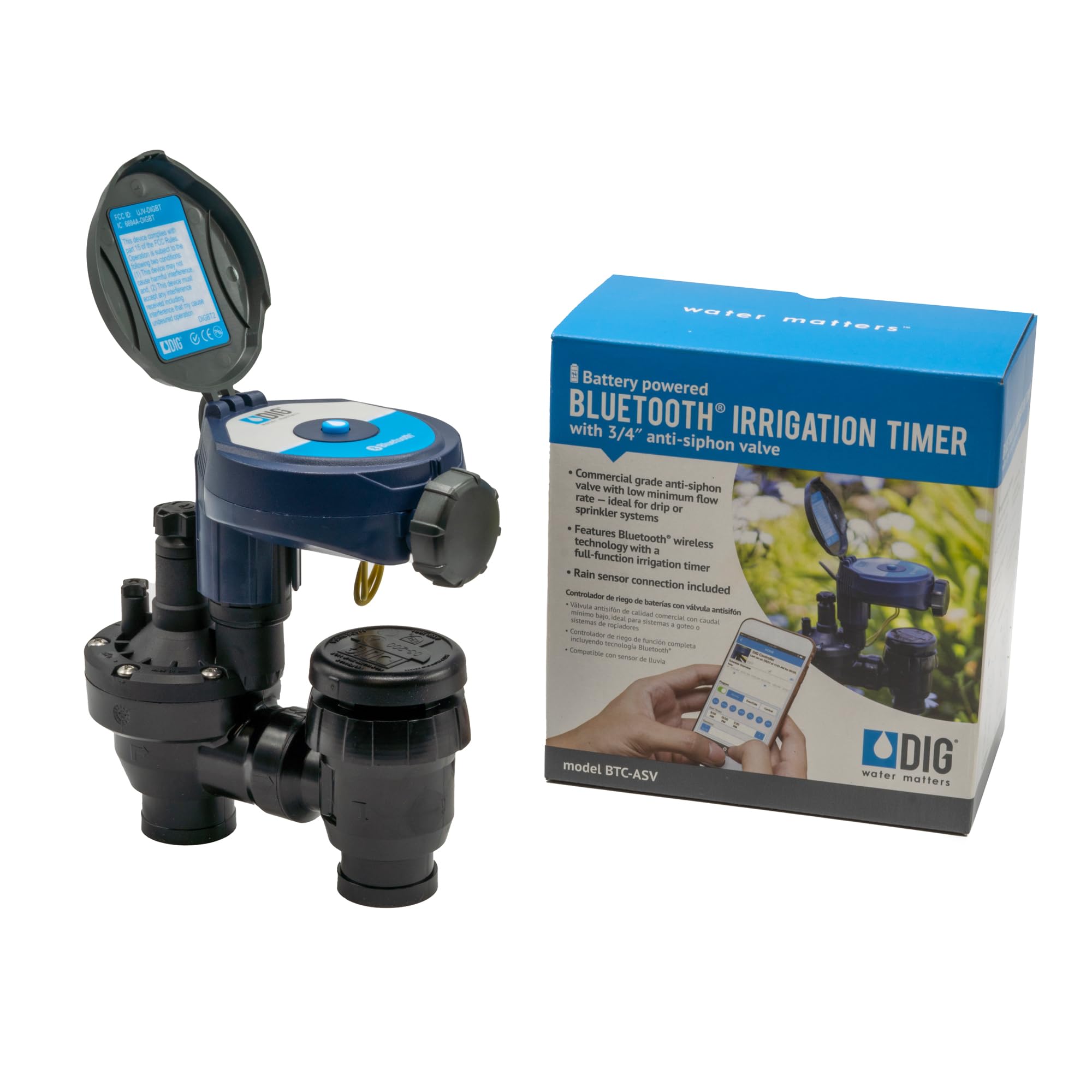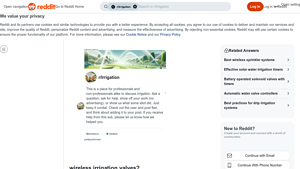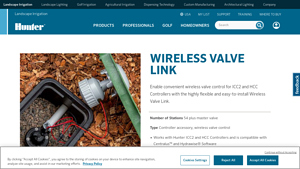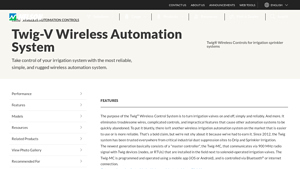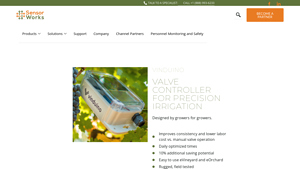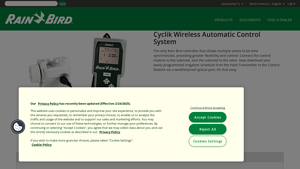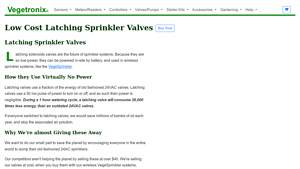Introduction: Navigating the Global Market for wireless irrigation valves
In today’s agricultural landscape, sourcing effective wireless irrigation valves is crucial for enhancing efficiency and reducing operational challenges. Traditional wired systems can lead to significant inefficiencies, from costly trenching to frequent maintenance, which can hinder productivity and profitability. This comprehensive guide delves into the various types of wireless irrigation valves available, their applications across diverse environments, and essential considerations for supplier vetting and cost analysis.
With a focus on international B2B buyers from Africa, South America, the Middle East, and Europe—regions characterized by unique agricultural needs—this resource aims to empower decision-makers with the knowledge to navigate the global market effectively. From understanding the technological advancements that allow for seamless integration with existing irrigation systems to exploring innovative solutions that mitigate common issues such as wiring failures and system downtime, this guide is designed to enhance informed purchasing decisions.
By equipping buyers with actionable insights and practical strategies, we aim to simplify the selection process for wireless irrigation valves, ensuring that businesses can optimize their water management systems and achieve their sustainability goals. Whether you are in Nigeria seeking efficient solutions for expansive farms or in Brazil looking to modernize urban irrigation systems, this guide serves as your essential tool for navigating the complexities of the wireless irrigation market.
Understanding wireless irrigation valves Types and Variations
| Type Name | Key Distinguishing Features | Primary B2B Applications | Brief Pros & Cons for Buyers |
|---|---|---|---|
| Battery-Powered Wireless Valves | Operates on batteries, easy installation, portable | Public parks, construction areas, rural properties | Pros: Easy to install, no wiring needed. Cons: Requires regular battery replacement. |
| Smart Controller-Integrated Valves | Connects with existing smart irrigation controllers | Large commercial landscapes, golf courses | Pros: Enhances existing systems, real-time monitoring. Cons: May need professional setup for integration. |
| Multi-Station Wireless Systems | Controls multiple stations from a single controller | Urban landscaping, traffic medians | Pros: Efficient water management, reduces infrastructure costs. Cons: Complexity in setup for larger systems. |
| Long-Range Communication Valves | Operates over extensive distances, often with repeaters | Agricultural applications, remote locations | Pros: Ideal for large areas, less signal interference. Cons: Higher initial investment for equipment. |
| Solar-Powered Wireless Valves | Utilizes solar energy for operation, eco-friendly | Sustainable landscaping, eco-parks | Pros: Low operational costs, environmentally friendly. Cons: Dependent on sunlight availability. |
What are Battery-Powered Wireless Valves and Their Applications?
Battery-powered wireless valves are designed for ease of use and portability, making them suitable for environments where wiring is impractical. They are commonly used in public parks, construction sites, and rural properties where traditional electrical connections may be challenging. The main purchasing consideration for B2B buyers is the frequency of battery replacement, which can impact long-term maintenance costs.
How Do Smart Controller-Integrated Valves Enhance Irrigation Systems?
Smart controller-integrated valves work seamlessly with existing smart irrigation systems, allowing for real-time adjustments based on weather conditions and soil moisture levels. These valves are particularly beneficial for large commercial landscapes and golf courses, where efficient water management is crucial. Buyers should consider compatibility with their current systems and the potential need for professional installation, which can add to initial costs but offers enhanced functionality.
What Are the Benefits of Multi-Station Wireless Systems?
Multi-station wireless systems enable the control of several irrigation zones from a single controller, making them ideal for urban landscaping and traffic medians. They help reduce infrastructure costs and streamline water management. However, the complexity of setting up these systems can be a challenge, particularly for larger projects. Buyers should assess their specific irrigation needs and the potential for system expansion when considering these options.
Why Choose Long-Range Communication Valves?
Long-range communication valves are designed for extensive coverage, often employing repeaters to maintain signal integrity over large areas. They are particularly useful in agricultural applications and remote locations where traditional wiring is not feasible. While they offer significant advantages in terms of coverage, the initial investment for the necessary equipment can be higher. Buyers should evaluate their operational scale and connectivity requirements before making a decision.
What Are the Advantages of Solar-Powered Wireless Valves?
Solar-powered wireless valves represent an eco-friendly choice for irrigation, utilizing renewable energy to operate. They are well-suited for sustainable landscaping projects and eco-parks, offering low operational costs due to their reliance on solar energy. However, their performance can be affected by the availability of sunlight, making it essential for buyers to assess their specific environmental conditions and energy needs before purchasing.
Key Industrial Applications of wireless irrigation valves
| Industry/Sector | Specific Application of wireless irrigation valves | Value/Benefit for the Business | Key Sourcing Considerations for this Application |
|---|---|---|---|
| Agriculture | Remote control of irrigation in large farms | Increases efficiency, reduces labor costs, and optimizes water usage | Compatibility with existing systems and local climate conditions |
| Landscaping | Automated watering in parks and public gardens | Enhances aesthetic appeal and reduces maintenance efforts | Vandal-resistant features and ease of installation |
| Urban Development | Irrigation for traffic medians and roundabouts | Improves urban greenery while minimizing water waste | Long-range communication capabilities and battery life |
| Construction | Temporary irrigation solutions on construction sites | Ensures plant health during development phases | Portability and ease of setup without disruption to site |
| Sports Facilities | Maintenance of turf in stadiums and recreational fields | Maintains optimal playing conditions, improving user experience | Durability and weather resistance for outdoor applications |
How Are Wireless Irrigation Valves Revolutionizing Agriculture?
In agriculture, wireless irrigation valves enable farmers to manage large areas remotely, optimizing water usage and reducing labor costs. These systems can be integrated into existing setups, allowing for seamless control over multiple zones. Buyers should consider local climatic conditions and the compatibility of these solutions with their current irrigation infrastructure to maximize efficiency and minimize water waste.
What Benefits Do Wireless Irrigation Valves Offer for Landscaping Projects?
In the landscaping sector, wireless irrigation valves provide automated watering solutions for parks and public gardens, enhancing aesthetic appeal while significantly reducing maintenance efforts. These systems are particularly valuable in areas prone to vandalism, as they often feature robust, vandal-resistant designs. When sourcing, businesses should prioritize ease of installation and the ability to integrate with existing landscape management systems.
How Are Wireless Irrigation Valves Used in Urban Development?
Urban development projects benefit from wireless irrigation valves by providing efficient irrigation for traffic medians and roundabouts, which helps maintain greenery in urban settings. This technology not only conserves water but also enhances the overall environment in densely populated areas. Buyers should focus on the long-range communication capabilities of these systems to ensure effective coverage across expansive urban landscapes.
Why Are Wireless Irrigation Valves Essential for Construction Sites?
Construction sites often require temporary irrigation solutions to maintain plant health during development phases. Wireless irrigation valves allow for quick setup and portability, ensuring that vegetation remains healthy without disrupting construction activities. Businesses must consider the ease of installation and the system’s adaptability to various site conditions when sourcing these solutions.
How Do Wireless Irrigation Valves Improve Sports Facility Maintenance?
In sports facilities, maintaining optimal turf conditions is crucial for user experience. Wireless irrigation valves facilitate precise watering schedules, ensuring that fields remain in peak condition for athletes. Durability and weather resistance are key factors for buyers in this sector, as these systems must withstand varying environmental conditions while providing reliable performance.
3 Common User Pain Points for ‘wireless irrigation valves’ & Their Solutions
Scenario 1: Navigating Complex Irrigation Landscapes
The Problem: Many B2B buyers, especially those managing large estates or agricultural lands, face significant challenges due to the complexity of existing irrigation systems. Traditional wired irrigation setups often require extensive trenching to connect controllers to valves. This not only disrupts the landscape but also incurs high labor costs and project delays. Additionally, buyers may struggle with divided systems where battery-operated timers fail to communicate effectively with the main controller, leading to inefficiencies in water management and customer dissatisfaction.
The Solution: To overcome these challenges, consider investing in advanced wireless irrigation valves like the Thrive EVO™ range. These products allow for seamless integration with existing systems without the need for trenching. By utilizing plug-and-play technology, you can easily connect multiple valves to your irrigation controller. Ensure that you select products that offer long-range wireless communication capabilities, ideally up to 700 yards in line of sight. This will help you manage up to four stations per device efficiently, eliminating the need for cumbersome wiring while maintaining effective control over your irrigation systems.
Scenario 2: Overcoming Battery Dependency and Maintenance Hassles
The Problem: Buyers often grapple with the limitations of battery-powered irrigation systems. Frequent battery replacements can lead to inconsistent performance and increased operational costs, particularly in regions with limited access to maintenance services. This issue is exacerbated in remote areas of Africa or South America, where logistical challenges can hinder timely battery replacements, resulting in downtime or inefficient irrigation practices.
The Solution: When sourcing wireless irrigation valves, opt for models that incorporate solar charging options or have long-lasting battery capabilities. For example, the Hunter WVC system is designed with a battery life that can last an entire season, minimizing maintenance interruptions. Additionally, select valves that feature clear battery life indicators to help anticipate replacements before they become critical. By implementing these proactive strategies, you can ensure continuous operation, reduce maintenance burdens, and optimize your irrigation management processes.
Scenario 3: Ensuring Compatibility and Future-Proofing Investments
The Problem: As technology evolves, many B2B buyers fear that their investments in irrigation systems may quickly become obsolete. This is particularly pertinent for businesses looking to integrate smart technology for enhanced water management but are concerned about compatibility issues with existing equipment. The risk of investing in wireless irrigation valves that do not integrate well with current controllers can lead to wasted resources and operational inefficiencies.
The Solution: To future-proof your irrigation system, prioritize wireless irrigation valves that offer broad compatibility with various controllers and technologies. Systems like the Hunter Wireless Valve Link are engineered to work seamlessly with a range of existing setups, allowing you to expand your irrigation capabilities without the need for a complete overhaul. When selecting products, inquire about their integration capabilities with smart controllers and software like Centralus™ or Hydrawise®. Additionally, consider the scalability of the system—look for options that allow you to easily add more valves as your operations grow. This strategic approach not only enhances your current irrigation management but also safeguards your investment against technological advancements.
Strategic Material Selection Guide for wireless irrigation valves
What Are the Common Materials Used in Wireless Irrigation Valves?
When selecting materials for wireless irrigation valves, it is crucial to consider performance, durability, and compatibility with various environmental conditions. Here, we analyze four common materials used in the construction of these valves: PVC, brass, stainless steel, and polyethylene.
How Does PVC Perform in Wireless Irrigation Valves?
PVC (Polyvinyl Chloride) is widely used in irrigation systems due to its excellent resistance to corrosion and low cost. PVC valves can typically handle temperatures up to 140°F (60°C) and pressures up to 150 psi, making them suitable for various irrigation applications.
Pros:
– Durability: Resistant to chemicals and UV rays, which is essential for outdoor applications.
– Cost-Effective: Generally lower in cost compared to metals, making it ideal for large-scale installations.
– Lightweight: Easier to handle and install, reducing labor costs.
Cons:
– Temperature Limitations: Not suitable for high-temperature applications beyond its rated capacity.
– Brittleness: Can become brittle over time, especially in colder climates.
For international buyers, compliance with standards such as ASTM D1784 is essential. PVC is commonly accepted in many regions, including Africa and South America, but buyers should ensure local regulations allow its use.
What Advantages Does Brass Offer for Wireless Irrigation Valves?
Brass is another popular material, known for its strength and resistance to corrosion. It can withstand higher temperatures and pressures, often rated up to 200°F (93°C) and 300 psi.
Pros:
– Durability: Highly resistant to corrosion, making it suitable for various water types, including saline and chlorinated water.
– High Performance: Excellent temperature and pressure ratings, ideal for demanding applications.
– Aesthetic Appeal: Offers a professional look, which may be important for high-end landscaping projects.
Cons:
– Cost: More expensive than PVC and polyethylene, which could impact budget considerations for large projects.
– Weight: Heavier than other materials, potentially increasing shipping costs and installation complexity.
Brass valves often meet international standards such as ASTM B283 and are favored in regions like Europe where quality and durability are prioritized.
Why Choose Stainless Steel for Wireless Irrigation Valves?
Stainless steel is renowned for its exceptional corrosion resistance and strength, making it ideal for harsh environments. It can handle temperatures up to 1,000°F (538°C) and high pressures, making it suitable for various applications.
Pros:
– Longevity: Extremely durable and resistant to rust and corrosion, ensuring a longer lifespan.
– Versatility: Suitable for a wide range of media, including aggressive chemicals.
– Maintenance-Free: Requires little to no maintenance over its lifespan.
Cons:
– Cost: Typically the most expensive option among the materials discussed.
– Manufacturing Complexity: More complex to manufacture, which may lead to longer lead times.
International buyers should ensure compliance with standards like ASTM A276 for stainless steel. Its high durability makes it a preferred choice in the Middle East and Europe.
How Does Polyethylene Compare for Wireless Irrigation Valves?
Polyethylene is often used in irrigation due to its flexibility and resistance to impact. It is rated for temperatures up to 140°F (60°C) and pressures around 100 psi.
Pros:
– Flexibility: Can be easily bent and shaped, allowing for easier installation in uneven terrains.
– Cost-Effective: Generally lower in cost, making it suitable for budget-conscious projects.
– Chemical Resistance: Excellent resistance to various chemicals, making it suitable for diverse applications.
Cons:
– Temperature Limitations: Not suitable for high-temperature applications.
– UV Sensitivity: Can degrade over time if exposed to UV light without proper protection.
Polyethylene complies with standards such as ASTM D1248, making it a viable option in many regions, including Africa and South America, where cost-effective solutions are often necessary.
Summary Table of Material Selection for Wireless Irrigation Valves
| Material | Typical Use Case for Wireless Irrigation Valves | Key Advantage | Key Disadvantage/Limitation | Relative Cost (Low/Med/High) |
|---|---|---|---|---|
| PVC | General irrigation systems | Cost-effective and lightweight | Temperature limitations | Low |
| Brass | High-end landscaping and saline water systems | High durability and aesthetic appeal | Higher cost | Med |
| Stainless Steel | Harsh environments and chemical applications | Exceptional corrosion resistance | Most expensive | High |
| Polyethylene | Flexible installations in varied terrains | Flexible and chemical resistant | UV sensitivity | Low |
By understanding the properties, advantages, and limitations of these materials, international B2B buyers can make informed decisions that align with their specific irrigation needs and regional compliance requirements.
In-depth Look: Manufacturing Processes and Quality Assurance for wireless irrigation valves
What Are the Main Stages of Manufacturing Wireless Irrigation Valves?
The manufacturing of wireless irrigation valves involves several critical stages, each crucial to ensuring product reliability and performance. These stages include material preparation, forming, assembly, and finishing.
Material Preparation: The process begins with sourcing high-quality materials, typically involving durable plastics, metals, and electronic components. Manufacturers often rely on suppliers that meet specific international standards. For example, metals used must withstand corrosion and environmental factors, while plastics should be UV resistant to ensure longevity.
Forming: Once materials are prepared, they undergo forming processes such as injection molding for plastic components or stamping for metal parts. This stage is pivotal as it shapes the components into their final form. Advanced techniques such as computer numerical control (CNC) machining may also be employed to ensure precision in critical parts, especially for electronic fittings and valve housings.
Assembly: The assembly stage integrates all components, including electronic circuits, solenoids, and valve bodies. This process may be manual or automated, depending on the scale of production. Quality control measures are implemented during assembly, where workers verify that components fit correctly and function as intended. This stage is also where wireless communication systems are integrated, ensuring compatibility with existing irrigation controllers.
Finishing: The final stage involves applying protective coatings, labeling, and conducting any additional treatments to enhance durability. This might include waterproofing measures and testing for resistance against environmental elements. The finishing touches ensure that the valves not only perform optimally but also meet aesthetic and branding standards.
How Is Quality Assurance Implemented in Wireless Irrigation Valve Manufacturing?
Quality assurance (QA) in the manufacturing of wireless irrigation valves is vital for ensuring that products meet both industry standards and customer expectations. Key international standards, such as ISO 9001, are often adopted, alongside industry-specific certifications like CE and API.
International Standards: ISO 9001 emphasizes a systematic approach to managing processes and improving quality. Manufacturers need to document their processes and implement continuous improvement practices to maintain certification. This standard is particularly important for B2B buyers who prioritize reliability and consistency in supply.
Quality Control Checkpoints: Various checkpoints throughout the manufacturing process help ensure product quality:
– Incoming Quality Control (IQC): This step involves inspecting raw materials and components as they arrive at the facility. Suppliers must provide documentation proving compliance with specified standards.
– In-Process Quality Control (IPQC): During the manufacturing process, random inspections are conducted to assess adherence to quality standards. This includes measuring dimensions and testing functionalities of components before they are assembled.
– Final Quality Control (FQC): After assembly, valves undergo rigorous testing, including functional tests, pressure tests, and wireless communication checks. Only products that pass these checks proceed to packaging.
What Testing Methods Are Commonly Used for Wireless Irrigation Valves?
Testing methods are essential for validating the performance and reliability of wireless irrigation valves. Common techniques include:
Functional Testing: Ensures that the valve operates as intended within various scenarios. This involves simulating real-world conditions to assess the valve’s response to different inputs.
Environmental Testing: Valves must be subjected to conditions such as extreme temperatures, humidity, and UV exposure to ensure they can withstand environmental stresses. This testing is critical for buyers in diverse climates, particularly in regions like Africa and South America.
Communication Range Testing: Given that these valves rely on wireless communication, manufacturers perform tests to confirm the effective range of communication between the valve and the controller. This ensures that the product will function correctly across various installation scenarios.
How Can B2B Buyers Verify Supplier Quality Control Practices?
For B2B buyers, particularly those in regions such as Africa, South America, the Middle East, and Europe, verifying a supplier’s quality control practices is crucial. Here are some actionable steps:
Supplier Audits: Conducting on-site audits of potential suppliers can provide insight into their manufacturing processes and quality assurance practices. This firsthand observation allows buyers to assess adherence to international standards and internal QA protocols.
Reviewing Quality Reports: Requesting documentation related to quality control processes, including IQC, IPQC, and FQC reports, can help buyers understand how the supplier maintains quality throughout production.
Third-Party Inspections: Engaging third-party inspection services can add an extra layer of assurance. These independent entities can verify compliance with international standards and assess the quality of products before shipment.
Certification Verification: Buyers should request copies of certifications such as ISO 9001, CE, and others relevant to the industry. Verification of these certifications ensures that the supplier meets established quality benchmarks.
What Are the Specific QC Considerations for International B2B Buyers?
International B2B buyers must navigate specific nuances in quality control when sourcing wireless irrigation valves:
Regulatory Compliance: Different regions have varying compliance requirements. For instance, CE marking is crucial for products sold in Europe, while other regions might have different certifications. Understanding these regulations is essential for ensuring products can be legally sold in the target market.
Supply Chain Transparency: Buyers should ensure their suppliers maintain transparency in their supply chain. This includes knowledge of where materials are sourced and how components are manufactured, which impacts overall product quality.
Cultural and Logistical Factors: Understanding cultural differences in business practices can aid in establishing effective communication with suppliers. Additionally, logistical considerations, such as shipping times and customs regulations, can impact the reliability of supply.
By focusing on these aspects, B2B buyers can ensure they source high-quality wireless irrigation valves that meet their operational needs while complying with international standards.
Practical Sourcing Guide: A Step-by-Step Checklist for ‘wireless irrigation valves’
This guide is designed to assist B2B buyers in effectively sourcing wireless irrigation valves. By following this checklist, you can ensure that you select the right products and suppliers to meet your operational needs while enhancing irrigation efficiency and reducing maintenance costs.
Step 1: Define Your Technical Specifications
Before diving into the procurement process, clearly outline the technical requirements for your wireless irrigation valves. Consider factors such as the operating range, compatibility with existing systems, and the number of stations you need to control. Understanding your specific needs will help you narrow down your options and facilitate discussions with suppliers.
Step 2: Research Market Trends and Innovations
Stay informed about the latest advancements in wireless irrigation technology. This includes understanding new features like battery life, communication range, and integration with smart controllers. Being aware of market trends will help you make informed decisions and ensure you are investing in cutting-edge solutions that provide long-term value.
Step 3: Evaluate Potential Suppliers
Before committing, it’s crucial to vet suppliers thoroughly. Request company profiles, case studies, and references from buyers in similar industries or regions. Look for suppliers with a proven track record in wireless irrigation solutions, as well as customer testimonials that speak to their reliability and support.
- Check Certifications: Ensure suppliers comply with relevant industry standards and regulations to guarantee product safety and performance.
- Assess Warranty and Support: A strong warranty and customer support system can be vital for addressing any issues post-purchase.
Step 4: Request Product Demonstrations
Once you have shortlisted potential suppliers, request product demonstrations or samples. This will allow you to assess the functionality and ease of installation of the wireless irrigation valves firsthand. Pay attention to how intuitive the controls are and whether the product meets your operational expectations.
Step 5: Compare Pricing and Total Cost of Ownership
Obtain detailed pricing from multiple suppliers and consider the total cost of ownership beyond the initial purchase price. Evaluate ongoing costs, such as battery replacements, maintenance, and potential upgrades. A lower initial price may not always translate to long-term savings, so consider the overall value proposition.
Step 6: Negotiate Terms and Conditions
Once you’ve selected a supplier, engage in negotiations to finalize terms and conditions. Discuss payment terms, delivery timelines, and installation support. Clear agreements can prevent misunderstandings and ensure a smoother procurement process.
Step 7: Plan for Future Scalability
As you finalize your procurement, consider how the wireless irrigation valves will fit into your long-term plans. Ensure that the products you choose are scalable and can integrate with future technologies or expansions. This foresight will help you maximize your investment and adapt to changing irrigation needs over time.
By following this checklist, B2B buyers can confidently navigate the sourcing process for wireless irrigation valves, ensuring they choose the right products and partners for their irrigation systems.
Comprehensive Cost and Pricing Analysis for wireless irrigation valves Sourcing
Understanding the cost structure and pricing dynamics of wireless irrigation valves is crucial for international B2B buyers looking to optimize their procurement strategies. This analysis delves into the various cost components, price influencers, and provides actionable buyer tips to ensure effective sourcing.
What Are the Key Cost Components in Wireless Irrigation Valves?
Materials: The primary materials used in wireless irrigation valves include durable plastics, metals for solenoids, and electronic components for wireless communication. The quality and source of these materials significantly impact the final price. High-grade materials may lead to increased upfront costs but can enhance the longevity and efficiency of the system.
Labor: Labor costs encompass the workforce involved in manufacturing, assembling, and testing the valves. Regions with higher labor costs, such as Europe, may see increased pricing compared to manufacturers in countries with lower labor costs, like some parts of Africa and South America.
Manufacturing Overhead: This includes the indirect costs associated with production, such as utilities, rent, and administrative expenses. Efficient manufacturing processes can help minimize these overheads, potentially leading to lower prices for buyers.
Tooling: The initial investment in tooling and machinery can be significant, especially for customized or specialized products. Buyers should consider whether the supplier has the capability to scale production without incurring excessive tooling costs.
Quality Control (QC): Rigorous QC measures are essential to ensure reliability and performance. The costs associated with QC processes can vary; however, investing in high-quality QC can reduce long-term warranty claims and maintenance costs.
Logistics: Shipping costs, including freight and insurance, are critical, especially for international buyers. Incoterms (International Commercial Terms) can influence logistics costs, with different terms affecting responsibility for shipping and insurance.
Margin: Suppliers typically add a margin to cover their costs and generate profit. Understanding the market dynamics and competitive landscape can provide insights into reasonable margins and potential negotiation leeways.
What Factors Influence Pricing for Wireless Irrigation Valves?
Volume and Minimum Order Quantity (MOQ): Larger orders often lead to discounts. Buyers should assess their needs and negotiate for better pricing based on volume commitments.
Specifications and Customization: Customized solutions may incur additional costs. Buyers should clearly define their requirements to avoid unexpected expenses and ensure they receive value for their investment.
Quality and Certifications: Products that meet international standards or have certifications (e.g., CE, IP68) may command higher prices but offer assurance of quality and compliance, which can be critical in certain markets.
Supplier Factors: The reputation and reliability of the supplier can impact pricing. Established suppliers may charge a premium for their proven track record and service quality.
Incoterms: The choice of Incoterms affects the total cost of ownership. Different terms determine who bears the shipping risks and costs, influencing the overall pricing structure.
What Are Effective Buyer Tips for Sourcing Wireless Irrigation Valves?
Negotiation: Engage suppliers in discussions about pricing, especially for larger orders. Understanding their cost structure can provide leverage during negotiations.
Focus on Total Cost of Ownership: Consider not just the purchase price but also long-term costs associated with maintenance, energy efficiency, and durability. A higher initial investment may yield lower operational costs.
Pricing Nuances for International Buyers: Be aware of currency fluctuations, import duties, and local taxes, which can affect the final pricing. Establishing relationships with local distributors may also reduce costs and improve service levels.
Research and Compare: Conduct thorough market research to compare prices and features across different suppliers. This can help identify the best value propositions.
In conclusion, a comprehensive understanding of the cost structure, pricing influencers, and strategic sourcing tips is essential for B2B buyers in the wireless irrigation valve market. By leveraging this knowledge, buyers can make informed decisions that align with their operational needs and budget constraints.
Alternatives Analysis: Comparing wireless irrigation valves With Other Solutions
Exploring Alternatives to Wireless Irrigation Valves
In the evolving landscape of irrigation technology, businesses often seek alternatives to wireless irrigation valves that can deliver similar efficiency and convenience. Understanding these alternatives helps buyers make informed decisions that align with their operational needs and budget constraints. Below, we compare wireless irrigation valves with two notable alternatives: traditional wired irrigation systems and battery-operated timers.
| Comparison Aspect | Wireless Irrigation Valves | Traditional Wired Irrigation Systems | Battery-Operated Timers |
|---|---|---|---|
| Performance | High efficiency with real-time control and integration with smart systems | Reliable but limited flexibility and prone to wiring issues | Basic functionality; limited features for advanced scheduling |
| Cost | Moderate upfront cost; long-term savings on maintenance | High initial installation costs due to trenching and materials | Low initial cost but higher ongoing battery replacement costs |
| Ease of Implementation | Quick setup with minimal disruption; no trenching required | Complex installation process; significant landscape disruption | Simple to install; however, limited in flexibility |
| Maintenance | Low maintenance; minimal wear and tear | High maintenance; wiring issues can lead to frequent repairs | Moderate maintenance; regular battery changes needed |
| Best Use Case | Ideal for complex landscapes needing flexibility and integration with smart systems | Suitable for permanent installations in stable landscapes | Best for temporary setups or budget-conscious projects |
What Are the Pros and Cons of Traditional Wired Irrigation Systems?
Traditional wired irrigation systems have long been the standard for landscape management. Their primary advantage lies in their reliability and established technology, which provides consistent performance. However, they come with significant downsides, including high installation costs due to the need for extensive trenching and wiring, which can disrupt existing landscapes. Additionally, troubleshooting wiring issues can be time-consuming, often requiring specialized labor, which can lead to increased maintenance costs over time.
How Do Battery-Operated Timers Compare?
Battery-operated timers offer a cost-effective solution for simple irrigation needs. They are easy to install and require minimal infrastructure, making them an attractive option for smaller projects or temporary setups. However, their performance is limited compared to wireless irrigation valves, particularly in terms of flexibility and smart integration. Users must also contend with the need for regular battery replacements, which can add up over time and create operational interruptions if not managed properly.
How Can B2B Buyers Choose the Right Irrigation Solution?
When evaluating irrigation solutions, B2B buyers should consider their specific operational needs, budget constraints, and the complexity of their landscapes. Wireless irrigation valves excel in providing advanced features and adaptability for intricate setups, making them ideal for larger or more dynamic environments. In contrast, traditional wired systems may suit businesses with established landscapes requiring less frequent updates, while battery-operated timers can serve those with limited budgets or temporary needs. Ultimately, understanding the unique advantages and limitations of each option will empower buyers to select the most suitable irrigation solution for their projects.
Essential Technical Properties and Trade Terminology for wireless irrigation valves
What Are the Key Technical Properties of Wireless Irrigation Valves?
When evaluating wireless irrigation valves, several technical properties are critical for ensuring performance and compatibility with existing systems. Understanding these specifications can significantly influence purchasing decisions.
Wireless Communication Range
The communication range defines how far the valve can be from the controller while maintaining a reliable connection. Typical ranges can be 700 yards in open areas and 200 yards through obstacles. For B2B buyers, a longer range reduces the need for multiple controllers, thereby simplifying system design and installation.Power Source and Battery Life
Most wireless valves operate on battery power, typically using 9-volt batteries. Battery life can vary, often lasting a full irrigation season. A longer battery life minimizes maintenance efforts and costs associated with frequent battery replacements, which is crucial for large installations in remote areas.Operating Temperature Range
Wireless irrigation valves must function effectively across a range of temperatures, typically from -20°F to 140°F. This specification is essential for regions with extreme weather, ensuring the valves operate reliably without failure. B2B buyers should consider local climate conditions when selecting products.Waterproof Rating (IP Rating)
The Ingress Protection (IP) rating indicates how well the valve can resist water and dust. A rating of IP68, for example, means the device can be submerged in water, making it suitable for outdoor applications. This property is vital for ensuring longevity and reducing maintenance costs, particularly in harsh environments.Material Grade
The materials used in valve construction, such as high-grade plastics or metals, affect durability and resistance to corrosion. For B2B buyers, selecting valves made from robust materials can reduce the frequency of replacements and enhance overall system reliability.Compatibility with Controllers
Ensuring that wireless valves are compatible with existing irrigation controllers is crucial. Many systems are designed to work seamlessly with both multi-wire and two-wire setups. Compatibility can reduce installation costs and time, allowing for easy upgrades without complete system overhauls.
What Are Common Trade Terms in the Wireless Irrigation Valve Industry?
Familiarizing oneself with industry terminology can facilitate smoother transactions and better communication with suppliers.
OEM (Original Equipment Manufacturer)
This term refers to companies that produce parts or equipment that may be marketed by another manufacturer. Understanding OEM relationships can help buyers identify the source of components and assess quality.MOQ (Minimum Order Quantity)
MOQ is the smallest number of units that a supplier is willing to sell. Knowing the MOQ is vital for budget planning and inventory management, especially for businesses looking to maintain a steady supply without overcommitting resources.RFQ (Request for Quotation)
An RFQ is a document sent to suppliers to request pricing and terms for specific products. B2B buyers often use RFQs to compare offers and negotiate better deals, making this a critical step in the procurement process.Incoterms (International Commercial Terms)
These are standardized trade terms that define the responsibilities of buyers and sellers in international transactions, including shipping, risk, and insurance. Understanding Incoterms is essential for global trade, ensuring clarity in contracts and reducing disputes.Lead Time
Lead time refers to the time taken from placing an order to receiving the product. For B2B buyers, shorter lead times can enhance project timelines and operational efficiency, making it an important factor in supplier selection.Warranty Period
This refers to the period during which a product is guaranteed against defects. A longer warranty period can indicate higher confidence in product quality and reliability, which is crucial for B2B buyers looking for long-term solutions.
By understanding these technical properties and trade terms, international B2B buyers can make informed decisions when selecting wireless irrigation valves, optimizing their investments and enhancing operational efficiency.
Navigating Market Dynamics and Sourcing Trends in the wireless irrigation valves Sector
What Are the Current Market Dynamics and Key Trends in Wireless Irrigation Valves?
The global market for wireless irrigation valves is experiencing significant growth, driven by increasing demand for efficient water management solutions amid climate change and water scarcity issues. International B2B buyers, particularly from regions like Africa, South America, the Middle East, and Europe, are seeking innovative technologies that enhance irrigation efficiency while reducing labor and operational costs. One of the most notable trends is the shift toward wireless technology, which eliminates the need for cumbersome wiring and trenching, thus simplifying installation and maintenance. This is particularly beneficial for buyers managing diverse landscapes, such as urban parks or agricultural fields, where traditional systems pose logistical challenges.
Emerging technologies like IoT-enabled controllers and wireless communication systems are transforming how irrigation systems are managed. For instance, solutions that connect existing systems wirelessly, such as Thrive EVO™ and Hunter’s Wireless Valve Link, are gaining traction. These products not only enhance operational efficiency but also allow for real-time monitoring and adjustments, enabling users to respond quickly to environmental changes. Furthermore, the trend towards battery-powered systems is appealing to regions with unreliable power supply, making wireless valves a practical choice for many international buyers.
How Does Sustainability and Ethical Sourcing Impact Wireless Irrigation Valve Procurement?
As businesses globally become more environmentally conscious, sustainability has emerged as a pivotal factor in sourcing decisions for wireless irrigation valves. The environmental impact of irrigation practices, especially in water-scarce regions, necessitates the adoption of solutions that promote water conservation and efficient resource use. Buyers are increasingly prioritizing products that incorporate sustainable materials and manufacturing processes, which not only reduce ecological footprints but also enhance brand reputation.
Ethical supply chains are also gaining importance, with buyers seeking manufacturers that adhere to fair labor practices and environmentally friendly production methods. Certifications such as ISO 14001 for environmental management and other ‘green’ labels are becoming critical criteria in supplier selection. These certifications provide assurance that the products meet specific environmental standards, thus appealing to B2B buyers committed to sustainability. As the demand for eco-friendly solutions continues to rise, suppliers that invest in sustainable practices will likely have a competitive edge in the market.
What Is the Brief Evolution of Wireless Irrigation Valve Technology?
The evolution of wireless irrigation valve technology has been marked by significant advancements in automation and communication. Initially, irrigation systems relied heavily on wired connections, which presented challenges such as high installation costs and maintenance issues. However, the introduction of wireless technology revolutionized this landscape, allowing for more flexible and efficient irrigation solutions. Early models focused primarily on battery-operated systems, which were limited in range and functionality.
Over the years, innovations such as long-range wireless communication and IoT integration have emerged, allowing for more complex and adaptable systems that cater to various user needs. Modern wireless irrigation valves now offer features like multi-station control and compatibility with smart irrigation controllers, making them suitable for a wide array of applications—from residential gardens to large agricultural operations. This evolution reflects a broader trend in the B2B sector towards increased efficiency, reduced labor costs, and enhanced sustainability in water management practices.
Frequently Asked Questions (FAQs) for B2B Buyers of wireless irrigation valves
How do I solve irrigation wiring issues effectively?
To address common irrigation wiring challenges, consider switching to wireless irrigation valves. Wireless systems eliminate the need for extensive wiring and trenching, allowing for quick installation and reduced maintenance. Brands like Thrive Smart Systems offer solutions that integrate seamlessly with existing controllers, enabling long-range communication without the hassle of traditional wiring. This not only saves time but also minimizes interruptions to your landscape, making it easier to manage irrigation effectively.What is the best wireless irrigation valve system for large properties?
For large properties, systems like the Hunter Wireless Valve Link are highly recommended. This system supports up to 54 valves with a communication range of over 2,000 feet, making it ideal for expansive areas. It operates on license-free LoRa technology, ensuring reliable performance without the need for copper wiring. Additionally, the system’s flexibility allows for easy integration with existing irrigation controllers, providing comprehensive control over your irrigation needs.What factors should I consider when sourcing wireless irrigation valves internationally?
When sourcing wireless irrigation valves, evaluate the supplier’s reliability, product quality, and compliance with international standards. Check for certifications like CE and IP ratings, which indicate quality and durability. Additionally, consider the supplier’s experience in exporting to your region, as they should be familiar with local regulations and logistics. Request samples to assess product performance before making bulk orders, ensuring that the valves meet your specific requirements.What are the typical payment terms for purchasing wireless irrigation valves?
Payment terms can vary based on the supplier and the size of your order. Common practices include a 30% deposit upon order confirmation, with the remaining balance due prior to shipment. For larger orders, you might negotiate longer payment terms or even financing options. It’s crucial to establish clear payment terms in your contract to avoid misunderstandings, especially when dealing with international transactions.How can I ensure the quality of wireless irrigation valves?
To ensure quality, request detailed product specifications and certifications from your supplier. Look for manufacturers with a strong reputation and positive customer reviews. Conduct a quality assurance (QA) process that includes inspecting samples and checking for compliance with international standards. Additionally, consider suppliers that offer warranties or guarantees, as this can provide further assurance of product quality.What is the minimum order quantity (MOQ) for wireless irrigation valves?
Minimum order quantities (MOQs) can vary significantly between suppliers. Some may offer MOQs as low as 10 units, while others may require orders of 100 or more. It’s essential to communicate your needs with potential suppliers to determine their MOQs and negotiate if necessary. If you’re unsure about committing to a large order, inquire about trial orders or sample purchases to test the product before scaling up.What logistics considerations should I keep in mind when importing wireless irrigation valves?
When importing wireless irrigation valves, consider shipping methods, customs regulations, and delivery timelines. Choose a reliable freight forwarder experienced in handling agricultural equipment to navigate potential challenges. Understand the import duties and taxes applicable to your region to avoid unexpected costs. Additionally, ensure that the supplier provides all necessary documentation, such as invoices and certificates of origin, to facilitate smooth customs clearance.How do I customize wireless irrigation valves for specific applications?
Customization options for wireless irrigation valves often depend on the manufacturer. Many suppliers can provide tailored solutions based on your specific requirements, such as valve size, control features, or compatibility with existing systems. Engage with the supplier early in the process to discuss your needs and explore available customization options. Be prepared to provide detailed specifications to ensure the final product meets your operational demands.
Important Disclaimer & Terms of Use
⚠️ Important Disclaimer
The information provided in this guide, including content regarding manufacturers, technical specifications, and market analysis, is for informational and educational purposes only. It does not constitute professional procurement advice, financial advice, or legal advice.
While we have made every effort to ensure the accuracy and timeliness of the information, we are not responsible for any errors, omissions, or outdated information. Market conditions, company details, and technical standards are subject to change.
B2B buyers must conduct their own independent and thorough due diligence before making any purchasing decisions. This includes contacting suppliers directly, verifying certifications, requesting samples, and seeking professional consultation. The risk of relying on any information in this guide is borne solely by the reader.
Top 8 Wireless Irrigation Valves Manufacturers & Suppliers List
1. Hunter – WVC Wireless Sprinkler Valve System
Domain: sprinklersupplystore.com
Registered: 2010 (15 years)
Introduction: {“product_name”: “Hunter WVC Wireless Sprinkler Valve System”, “description”: “Multi-Station, Multi-Function, Battery-Powered Control & Programming. The WVP Wireless Valve Programmer and battery-powered WVC Wireless Valve Controller work together to create a wireless sprinkler valve system that provides multi-station control when a standard electrical wire connection is unavailable.”, “applicable_…
2. Wireless Irrigation Solutions – Wireless Control Valves
Domain: reddit.com
Registered: 2005 (20 years)
Introduction: Wireless irrigation valves are being discussed in the context of a home irrigation system where the existing wires have been cut. Users are looking for commercial products that allow for wireless control of irrigation systems without the need to re-run wires. Options mentioned include battery-operated nodes and Bluetooth versions of controllers, such as the Hunter Node, which can be easier to use …
3. Hunter – Wireless Valve Link
Domain: hunterirrigation.com
Registered: 2001 (24 years)
Introduction: Product Name: Wireless Valve Link
Type: Controller accessory, wireless valve control
Compatible Controllers: Hunter ICC2 and HCC Controllers
Software Compatibility: Centralus™ and Hydrawise® Software
Number of Stations: Up to 54 valves plus master valve (P/MV)
Wireless Range: Up to 2,000′ line-of-sight or more with a Repeater
Technology: License-free LoRa Technology for wireless communication
Inst…
4. Nelson Irrigation – Twig® Wireless Automation System
Domain: nelsonirrigation.com
Registered: 1999 (26 years)
Introduction: Twig® Wireless Automation System is designed for farm irrigation sprinkler systems, providing reliable and simple control of irrigation valves. Key features include:
– Wireless operation eliminating the need for troublesome wires and complicated controls.
– The system consists of a master controller (Twig-MC) that communicates via 900 MHz radio signal with field devices (nodes or RTUs).
– The T…
5. Hunter – WVL-400 4-Station Wireless Valve Link
Domain: cheapsprinklers.com
Registered: 2014 (11 years)
Introduction: {“product_name”: “Hunter WVL-400 4-Station Wireless Valve Link”, “sku”: “WVL400”, “price”: “$242.00”, “original_price”: “$408.00”, “description”: “The Wireless Valve Link enables wire-free valve control and monitoring for new, existing, and add-on valves in ICC2 or HCC control systems. It allows adding valves up to 2,000′ without new wiring, providing a flexible solution for complex landscapes.”, …
6. SensorWorks – Vinduino Valve Controller
Domain: sensorworks.net
Registered: 2013 (12 years)
Introduction: Wireless Irrigation Valve Controller – Vinduino Valve Controller for Precision Irrigation. Designed by growers for growers. Improves consistency and lowers labor costs compared to manual valve operation. Daily optimized times with 10% additional saving potential. Easy to use with eVineyard and eOrchard software. Features include: controls up to 5 DC latching irrigation valves or 1 master valve/pum…
7. Rain Bird – Cyclik Wireless Control System
Domain: rainbird.com
Registered: 1995 (30 years)
Introduction: Cyclik Wireless Automatic Control System by Rain Bird allows for multiple valves to be time synchronized, providing flexibility and control. It is battery-operated, eliminating the need for AC power and control wires. The control module operates latching solenoids to manage water flow to up to four valves. The system includes a field transmitter for programming irrigation schedules for up to 85 co…
8. Vegetronix – Latching Sprinkler Valves
Domain: vegetronix.com
Registered: 2008 (17 years)
Introduction: Latching Sprinkler Valves: Low-cost, low-power latching solenoid valves designed for sprinkler systems. They can be powered by battery and used in wireless systems like the VegeSprinkler. Latching valves consume a fraction of the energy compared to traditional 24VAC valves, using only a 50 ms pulse of power to operate. During a 1-hour watering cycle, they consume 36,000 times less energy than outd…
Strategic Sourcing Conclusion and Outlook for wireless irrigation valves
As the global demand for efficient irrigation solutions rises, investing in wireless irrigation valves offers significant advantages for businesses aiming to enhance their water management systems. The shift from traditional wired systems to wireless technology not only reduces installation complexities and costs associated with trenching but also minimizes maintenance challenges. With products like the Thrive EVO™ and Hunter WVC systems, users can achieve greater flexibility, scalability, and reliability, ensuring optimal performance even in challenging environments.
Strategic sourcing of these innovative solutions is crucial for B2B buyers, particularly in regions such as Africa, South America, the Middle East, and Europe, where water scarcity and management efficiency are paramount. By prioritizing wireless irrigation valves, businesses can streamline their operations, reduce downtime caused by wiring issues, and align their practices with sustainable water management goals.
Looking ahead, the integration of smart technology in irrigation systems will continue to evolve. International buyers are encouraged to explore partnerships with leading suppliers to stay ahead in this competitive landscape. Embrace the future of irrigation—connect with your suppliers today and revolutionize your irrigation strategy for lasting impact.

